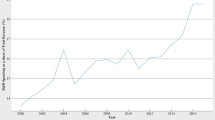Abstract
Background
As of 2015, the Japanese pharmaceutical market was the world’s third largest pharmaceutical market. Although previous studies have examined market differences in terms of market size and pricing policy, little is known about comparative market configurations. The present study provides a comparative analysis of pharmaceutical market configurations in Japan and five other markets.
Methods
Based on data for the 100 top-selling drugs in 2014 in Japan, the United States, the United Kingdom, France, Germany, and the global market, we explored differences in market configurations using the Herfindahl–Hirschman Index, Lorenz curves, and Gini coefficients. We also investigated market trends by analyzing changes in sales, sales volume, and price.
Results
The 100 top-selling drugs accounted for a lower share of the total market in Japan, France, and Germany as compared to the United States and the United Kingdom. The market deviation of the 100 top-selling drugs indicated by the Herfindahl–Hirschman Index and Gini coefficient was smallest in Japan. Sales of most of the top-100 drugs increased in all the countries studied; however, directional price changes differed by country and sales volume trend.
Conclusion
Our findings showed that market deviations in Japan were relatively low compared with those in other developed countries, suggesting that some of the more beneficial drugs in other developed countries obtain relatively fewer benefits from the Japanese pharmaceutical market, and some less beneficial drugs obtained more benefits.


Similar content being viewed by others
References
Shibata S, Uemura R, Suzuki T. Comparative analysis between the top-selling drugs in the Japanese pharmaceutical market and those in the United States, the United Kingdom, France, and Germany. Ther Innov Regul Sci. 2016;50(2):221–7.
Danzon PM. Differential pricing of pharmaceuticals: theory, evidence and emerging issues. Pharmacoeconomics. 2018;36(12):1395–405.
Danzon PM, Chao L. Cross-national price differences for pharmaceuticals: how large, and why? J Health Econ. 2000;19(2):159–95.
Garattini L, Motterlini N, Cornago D. Price and distribution margins of in-patient drugs in pharmacy: a comparison in seven European countries. Health Policy. 2008;85(3):305–13.
Kyle MK. Pharmaceutical price controls and entry strategies. Rev Econ Stat. 2007;89(1):88–99.
World Health Organization Collaborating Center for Drug Statistic Methodology. ATC code. https://www.whocc.no/atc_ddd_index/. Accessed 9 Dec 2018.
Kobayashi D, Otsubo T, Imanaka Y. The effect of centralization of health care services on travel time and its equality. Health Policy. 2015;119:298–306.
Shibata S, Suzuki T. The pharmaceutical market and drug development prognosis in Japan: current and future perspectives according to pharmacological classes. J Generic Med. 2018;14(2):70–80.
Shibata S, Uemura R, Suzuki T. Factors that affect the acquisition of reward premiums for promotion of innovative drug discovery in Japan. Ther Innov Regul Sci. 2016;50(1):56–655.
Shibata S, Uemura R, Suzuki T. Impact of premium rewards for the promotion of innovative drug discovery on the Japanese pharmaceutical market: an analysis by therapeutic area. Ther Innov Regul Sci. 2016;50(1):49–55.
Fukumoto D, Tsuyuki A, Suzuki T. Drugs targeted for price cutting in Japan: the case of price revisions based on the divergence of official versus delivery prices. Ther Innov Regul Sci. 2017;51(5):597–603.
Fukumoto D, Suzuki T. Impact of generic entry to off-patent branded medicines in Japanese pharmaceutical market. J Generic Med. 2017;13(3):114–22.
Shibata S, Matsushita M, Saito Y, Suzuki T. Optimal anti-cancer drug profiles for effective penetration of the anti-cancer drug market by generic drugs in Japan. Ther Innov Regul Sci. 2017;52(4):442–8.
Shibata S, Matsushita M, Saito Y, Suzuki T. Anticancer drug prescription patterns in Japan: future directions in cancer therapy. Ther Innov Regul Sci. 2018;52(6):718–23.
Shibata S, Wayama Y, Tsuyuki A, Matsushita M, Chiba K, Matsuki E, et al. An empirical study of the prescription pattern of drugs for hematological malignancies in Japan from 2010–2014. Biol Pharm Bull. 2017;40(6):894–901.
Shibata S, Noguchi E, Matsushita M, Suzuki T, Ozaki K. Can rare cancer drugs expect sales in Japan? A prescription pattern analysis of drugs for chronic myelogenous leukemia and neuroendocrine tumor. J Reg Sci. 2019;7:1–9.
Glenn TL. Are we global now? Local vs. foreign sources of corporate competence: the case of the Japanese pharmaceutical industry. Strategic Manage J. 2004;25(8–9):865–86.
Funding
This work was supported in part by Keio Gakuji Academic Development Funds and the Ministry of Education, Culture, Sports, Science and Technology (MEXT) Supported Program for the Strategic Research Foundation at Private Universities (TS).
Author information
Authors and Affiliations
Corresponding author
Ethics declarations
Conflict of interest
Shoyo Shibata is an employee of Chugai Pharmaceutical Co., Ltd. However, his affiliation with the company did not influence the results or discussion in this paper. Daigo Fukumoto, Takeshi Suzuki, and Koken Ozaki have no conflicts of interest to disclose.
Additional information
Publisher's Note
Springer Nature remains neutral with regard to jurisdictional claims in published maps and institutional affiliations.
Rights and permissions
About this article
Cite this article
Shibata, S., Fukumoto, D., Suzuki, T. et al. A Comparative Study of the Market Configuration of the Japanese Pharmaceutical Market Using the Gini Coefficient and Herfindahl–Hirschman Index. Ther Innov Regul Sci 54, 1047–1055 (2020). https://doi.org/10.1007/s43441-020-00122-6
Received:
Accepted:
Published:
Issue Date:
DOI: https://doi.org/10.1007/s43441-020-00122-6




